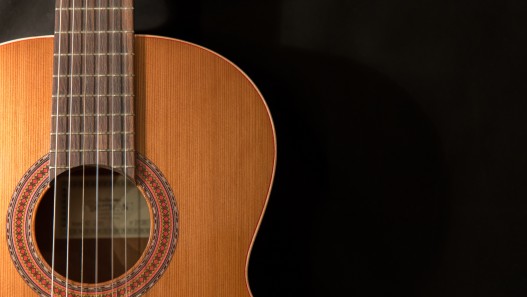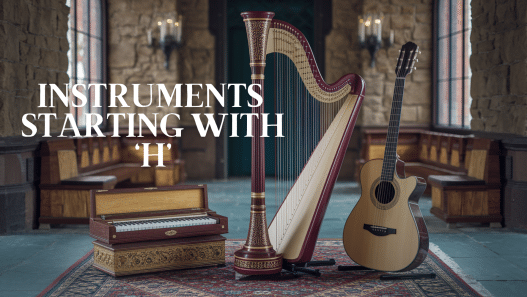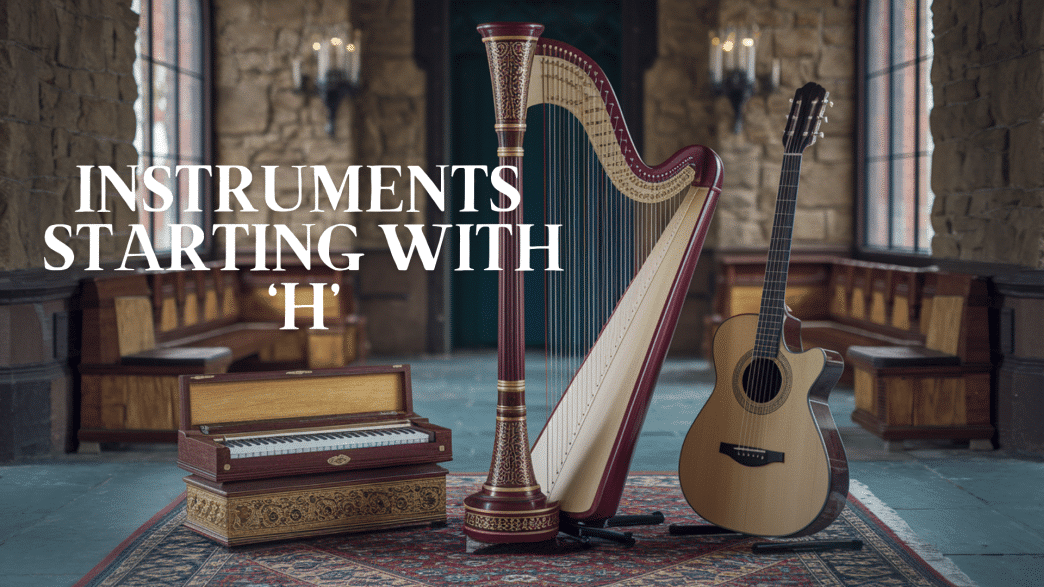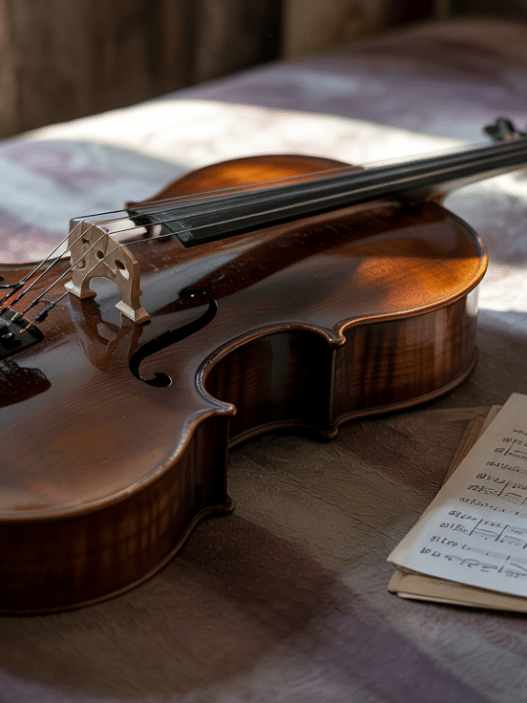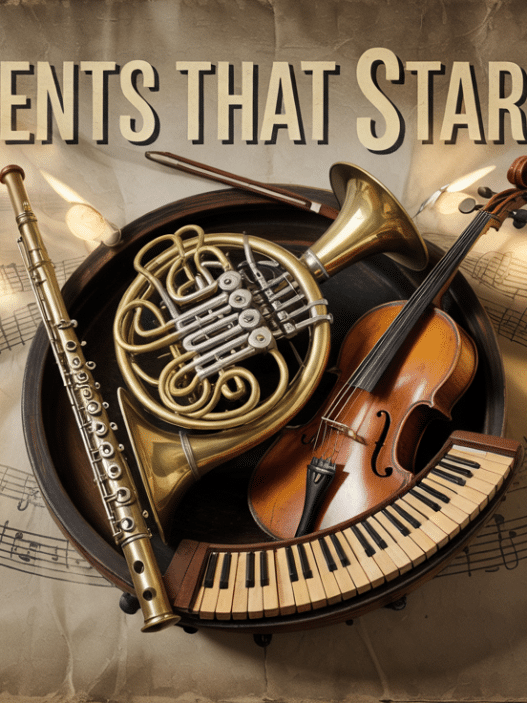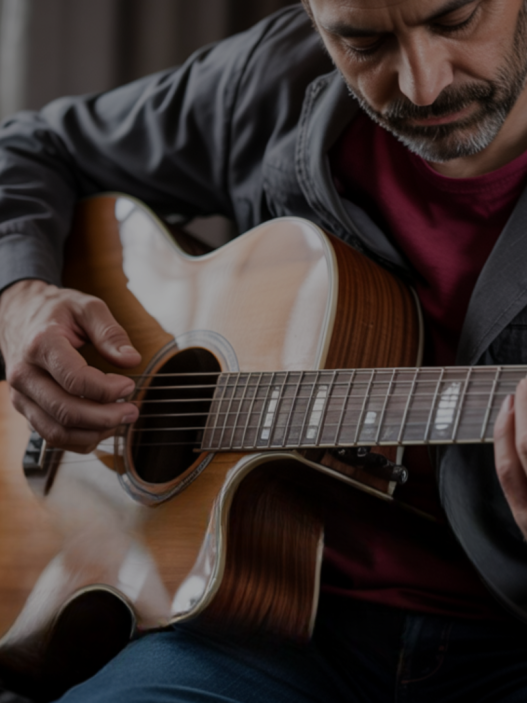“Did you know the first guitar-like instrument was played over 3,500 years ago?”
Music has been with us since the dawn of time, shaping cultures and bringing people together. That humble harp in your school music room? It has cousins in almost every nation on earth.
The world of music is huge, with thousands of instruments from every corner of the globe. Some you know well, but others might be complete mysteries.
Hidden among the alphabet are some true musical gems that start with the letter H. These instruments have shaped music across different cultures and periods.
Ready for a musical ride? This list of H-named instruments will open your ears to new sounds and maybe inspire you to pick one up yourself. From the familiar to the fantastically rare, each one has a unique story to tell.
Popular Instruments Starting with H
These instruments have made their mark on music worldwide. You’ve probably heard them in your favorite songs or seen them in concerts. Some might even be sitting in your school’s music room right now!
1. Harmonica
The harmonica is a small, portable wind instrument often used in blues, rock, and folk music. It’s played by breathing in and out through the holes to produce different sounds.
- Origin: The harmonica originated in Europe during the 19th century and later became widely associated with American blues music.
- Sound: It has a soulful and expressive sound, with a mix of melodic and rhythmic qualities.
- How it works: By blowing and inhaling through the harmonica’s holes, air vibrates metal reeds inside the instrument to produce sound.
- Interesting fact: Bob Dylan is known for his harmonica playing, especially in his hit song “Blowin’ in the Wind.”
2. Harp
The harp is a beautiful, large string instrument known for its soothing, melodic tones. It’s played by plucking the strings, which are stretched over a frame.
- Origin: The harp is one of the oldest string instruments, dating back to ancient Mesopotamia and Egypt.
- Sound: It produces a rich, resonant, and often ethereal sound.
- How it works: Plucking the strings with fingers produces sound, with each string tuned to a specific note.
- Interesting fact: The harp has been used in both ancient and classical music, and its soothing tones are often featured in symphonies and choirs.
3. Horn
The horn is a brass wind instrument with a bold, deep sound, often used in orchestras and brass bands.
- Origin: The horn has ancient roots, originally made from animal horns, and later evolved into modern brass horns around the 17th century.
- Sound: It has a strong, mellow, and resonant tone that can be both bright and bold.
- How it works: You blow into the mouthpiece, and by pressing valves and adjusting your hand in the bell, you control the pitch.
- Interesting fact: The horn is widely used in orchestras and often features in film scores, creating a powerful, cinematic effect.
4. Handbell
A handbell is a small bell held in one hand and rung to create a clear, bell-like sound. It’s often seen in choirs and churches.
- Origin: Handbells originated in Europe, used in monasteries as signals for prayer times, and later evolved into musical instruments.
- Sound: The sound is bright, clear, and resonant, often heard in church choirs and bell ensembles.
- How it works: The bell is shaken by hand to create sound, with different sizes and pitches of bells creating harmonies.
- Interesting fact: In a handbell choir, several musicians play different bells to create beautiful harmonies, often for festive occasions.
5. Harpsichord
The harpsichord is a keyboard instrument known for its plucked-string sound, popular during the Baroque period.
- Origin: The harpsichord dates back to the 14th century in Europe, particularly in Italy and the Netherlands.
- Sound: It produces a bright, metallic sound due to the plucking of strings rather than striking them like a piano.
- How it works: When a key is pressed, a plectrum plucks a string to produce sound, and the pitch depends on the length and tension of the string.
- Interesting fact: The harpsichord was widely used by composers such as Bach and Handel during the Baroque period, before the piano became popular.
6. Hurdy-Gurdy
The hurdy-gurdy is a unique stringed instrument that is played by turning a crank to make the strings vibrate.
- Origin: Originating in medieval Europe, it was commonly used in France and Spain.
- Sound: The sound is a continuous drone, with melodies played using the keyboard to press the strings.
- How it works: A crank turns a wheel that rubs against the strings, and the keys are used to change the pitch while the wheel continues to turn.
- Interesting fact: The hurdy-gurdy was sometimes called the “wheel fiddle” due to its crank-operated mechanism.
7. Harmonium
The harmonium is a pump organ that is primarily used in Indian classical music and devotional settings.
- Origin: The harmonium was invented in the 19th century in Europe and was later adapted into Indian music during the colonial period.
- Sound: It produces a rich, full-bodied sound and is often used in religious and folk music.
- How it works: It is played by pumping air through bellows and pressing the keys to produce sound from the pipes.
- Interesting fact: The harmonium is an essential instrument in Indian classical music, often used in bhajans (devotional songs).
8. Harp Guitar
The harp guitar is a guitar with additional strings that extend beyond the standard six, allowing it to create a broader range of sounds.
- Origin: The harp guitar has roots in both Western and Eastern music traditions and was popularized in the 19th century.
- Sound: It produces a fuller, more resonant tone than a regular guitar, with deep bass and bright treble sounds.
- How it works: The instrument has both plucked strings (like a guitar) and extra bass strings that are played by the thumb or fingers.
- Interesting fact: The harp guitar was used by composers like Andrés Segovia and Leo Kottke to create unique compositions.
9. Hornpipe
The Hornpipe is a traditional woodwind instrument used in folk music, especially in English and Irish traditions.
- Origin: The Hornpipe originated in Europe and was used in folk music and dance, particularly in Britain and Ireland.
- Sound: It produces a bright, sharp sound that is characteristic of many folk dances.
- How it works: It is played by blowing air through a reed to create a pitched sound, with finger holes used to alter the notes.
- Interesting fact: The Hornpipe is also associated with sailors, as it was commonly used on ships in the past for entertainment.
10. Hi-hat
The hi-hat is a pair of cymbals in a drum kit, played by a foot pedal and used extensively in jazz, rock, and pop music.
- Origin: The hi-hat was introduced in the early 20th century as part of the evolution of the modern drum kit.
- Sound: The hi-hat produces a crisp, sharp “chick” sound when the cymbals are struck with a foot pedal.
- How it works: The hi-hat consists of two cymbals that are controlled by a foot pedal to open and close, creating different sound effects.
- Interesting fact: The hi-hat became a vital part of the drum kit in jazz, especially with drummers like Gene Krupa, who helped popularize its use.
Lesser-Known Instruments Starting with H
Now, let’s see some hidden musical treasures! These rare instruments might not be household names, but they create amazing sounds and have rich histories. Get ready to find some truly unique ways people make music around the world.
11. Haegeum
The Haegeum is a traditional Korean stringed instrument, similar to a fiddle, played with a bow.
- Origin: The Haegeum has been part of Korean music for over a thousand years, often used in both classical and folk performances.
- Sound: It produces a rich, haunting sound that blends well with both ensemble music and solo performances.
- How it works: Played with a bow, it has two strings and is held upright, with the player’s fingers pressing the strings to produce different pitches.
- Interesting fact: The Haegeum is often featured in traditional Korean performances, such as court music and Korean opera.
12. Huangqin
The Huangqin is a Chinese bowed string instrument, similar to a violin, and is used in traditional Chinese operatic music.
- Origin: It originated in China and has been a part of traditional Chinese music for centuries.
- Sound: The Huangqin produces a mellow, high-pitched sound, often heard in Chinese opera and folk performances.
- How it works: Played with a bow, the Huangqin has silk strings that are drawn across the instrument to create a soft, resonant sound.
- Interesting fact: The Huangqin is particularly important in Chinese operatic performances, especially in the Jiangnan and Kunqu opera styles.
13. Helicon
The Helicon is a large, coiled brass instrument similar to the tuba but designed for marching bands.
- Origin: It was invented in the 19th century in Europe and was designed to be more portable for marching brass players.
- Sound: It produces a deep, resonant bass sound, which is essential for providing the foundation in marching bands.
- How it works: Played like a tuba, it’s held upright and wrapped around the player’s body, producing rich low notes.
- Interesting fact: The Helicon is essential for marching bands, adding a powerful, deep bass sound that grounds the rest of the brass section.
14. Handpan
The Handpan is a relatively new percussion instrument made from metal, producing melodic, resonating sounds.
- Origin: The Handpan was developed in the early 2000s in Switzerland by Felix Rohner and Sabina Schärer.
- Sound: It has a unique, melodic sound with a rich, warm tone that resonates for a long time.
- How it works: Played with the hands and fingers, the player taps the handpan’s metal surface to create a variety of pitches and rhythms.
- Interesting fact: The Handpan gained worldwide popularity after videos of its mesmerizing sound went viral on the internet.
15. Hungarian Cimbalom
The Hungarian Cimbalom is a type of hammered dulcimer popular in Hungarian music, known for its unique and resonant sound.
- Origin: The Cimbalom originated in Hungary and is integral to the country’s traditional music, especially in folk performances.
- Sound: It produces a bright, percussive sound when struck with mallets.
- How it works: The instrument consists of a large, flat wooden body with strings stretched over it. The strings are struck with mallets to produce sound.
- Interesting fact: The Cimbalom is often featured in Hungarian folk bands and is the centerpiece of many traditional performances.
16. Hydraulis
The Hydraulis is an ancient Greek water organ, considered one of the first known keyboard instruments.
- Origin: It was invented in ancient Greece in the 3rd century BCE and was powered by water to create sound.
- Sound: It produced a rich, powerful sound similar to that of a pipe organ and was used for large public events.
- How it works: Water was used to regulate air pressure in the instrument’s pipes, which allowed it to create sound when air was blown through them.
- Interesting fact: The Hydraulis is a precursor to the modern pipe organ and was used in ancient Greek and Roman theaters.
17. Hasapi
The Hasapi is a traditional percussion instrument from the Philippines, similar to a drum but typically made from a wooden frame and stretched animal skin.
- Origin: The Hasapi comes from various ethnic groups in the Philippines and is used in ritualistic and ceremonial performances.
- Sound: The Hasapi produces a deep, resonating sound, often used to accompany dance and traditional music.
- How it works: It is played by striking the stretched skin with hands or mallets. The drumhead’s size and tension determine the rhythmic sound.
- Interesting fact: The Hasapi is often featured in Filipino festivals and is an important part of cultural rituals.
Wrapping Up Our Musical Ride
From the famous harmonica to the rare Hydraulis, H-instruments show us just how creative humans can be when making music. Each instrument has its special voice and story to tell.
Music connects us all, no matter where we come from or what language we speak. These instruments are just a small sample of the ways people around the world express themselves through sound.
Which H-instrument caught your attention the most? Maybe it’s time to try playing one yourself! Local music shops often have lessons for beginners, and many online tutorials can help you get started.
Share this article with a friend who loves music, and let us know in the comments which instrument you’d like to learn. Your musical adventure is just beginning!
Curious about other instruments too? You might find your next favorite musical instrument here.






